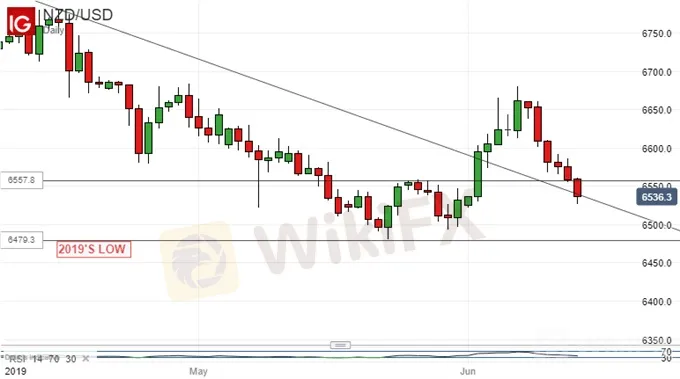简体中文
繁體中文
English
Pусский
日本語
ภาษาไทย
Tiếng Việt
Bahasa Indonesia
Español
हिन्दी
Filippiiniläinen
Français
Deutsch
Português
Türkçe
한국어
العربية
Asian Stocks Mixed As US, Iran Trade Accusations Over Tanker Attacks
Abstract:Regional equity had a narrow and mixed session Friday with Middle Eastern tensions back to the fore. Pro-risk currencies struggled much more obviously.
Asian Stocks Talking Points:
Fridays equity session saw markets trendless overall
Washington and Tehran both had their say over Thursdays attack on two oil tankers
The Dollar looked to next week and the Federal Reserves policy call
Find out what retail foreign exchange investors make of your favorite currencys chances right now at the DailyFX Sentiment Page
Asia Pacific stock markets put in a mixed showing to end the week with overall risk appetite capped by Thursdays attacks on two oil tankers in the Gulf of Oman.
The US State Department has pinned the blame for them squarely in Iran, while stressing the need for diplomacy. For its part Tehran has denied involvement. The story has already seen oil prices rise, with the Dow gaining just over 100 points on Thursday as the energy sector gained.
International benchmark Brent rather drifted through the Asian session, coming off its Thursday highs but not by very much. There are signs that it is edging up again as the European open approaches.
Obviously much market emphasis is now on next weeks monetary policy meeting of the US Federal Reserve. The central bank meets on Wednesday and, while no changes are expected, the market is now looking for an interest rate cut in July. The extent to which any commentary supports this thesis will probably be crucial across markets.
The US Dollar was a little higher against major rivals and on-track for a weekly gain, however. The Australian and New Zealand Dollars were pressured by lower bond yields after some miserable Purchasing Managers Index numbers out of the latter‘s homeland. It’s clear that the Fed is far from the only central bank thought highly likely to cut interest rates in the near future.
NZD/USD has now retraced its steps back into the old daily-chart trading range which last endured between mid-May and the start of June.

The pair is also very close to its former long downtrend line, with a weekly close below that likely to bring the years lows back into very close consideration.
The rest of the trading day will offer investors plenty to chew over, with US retail sales figures for May coming up, along with the University of Michigans venerable consumer sentiment snapshot.
Disclaimer:
The views in this article only represent the author's personal views, and do not constitute investment advice on this platform. This platform does not guarantee the accuracy, completeness and timeliness of the information in the article, and will not be liable for any loss caused by the use of or reliance on the information in the article.
Read more

GEMFOREX - weekly analysis
The week ahead: Top 5 things to watch

NZD/USD Grapples 0.7000 With RBNZ’s Inflation Expectations Survey on Deck
New Zealand Dollar holds firm while risk-sensitive Australian Dollar falls overnight. RBNZ's inflation expectations survey in focus as the central bank’s rate decision nears. NZD/USD looks to retake the 0.7000 psychological level after bouncing from support

All Round Major Pairs Technical Analysis: EUR/USD, AUDUSD, And GBPUSD
The start of November has been a dwindling moment for the general major currency market. As essential economic updates flood the surface of the entire foreign exchange market, in which most of the currency pairs especially the major pairs were greatly affected by the impact of the economic releases. However, the US dollar was discovered to have held the main currency exchange performance metrics as the central economic updates from the US region tend to have determined the significant changes that have occurred in the major currency market so far.

Japanese Yen Technical Analysis: EUR/JPY, CAD/JPY. What Happened to Momentum?
JAPANESE YEN, EUR/JPY, CAD/JPY - TALKING POINTS AND ANALYSIS
WikiFX Broker
Latest News
Interactive Brokers Launches Forecast Contracts in Canada for Market Predictions
Authorities Alert: MAS Impersonation Scam Hits Singapore
INFINOX Partners with Acelerador Racing for Porsche Cup Brazil 2025
The Impact of Interest Rate Decisions on the Forex Market
Billboard Warns of Crypto Scams Using Its Name – Stay Alert!
STARTRADER Spreads Kindness Through Ramadan Campaign
How a Housewife Lost RM288,235 in a Facebook Investment Scam
Rising WhatsApp Scams Highlight Need for Stronger User Protections
A Trader’s Worst Mistake: Overlooking Broker Reviews Could Cost You Everything
The Daily Habits of a Profitable Trader
Currency Calculator







